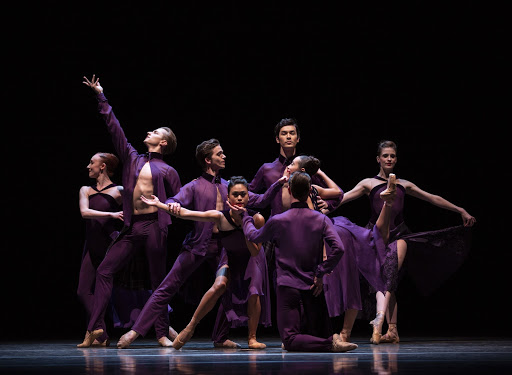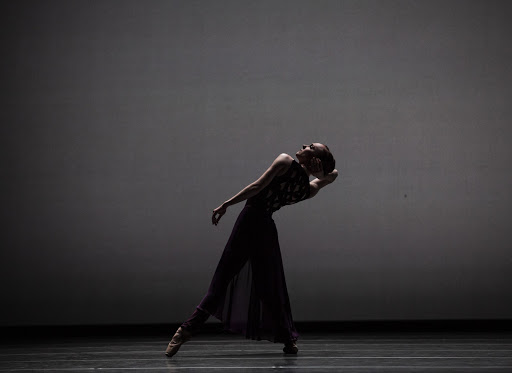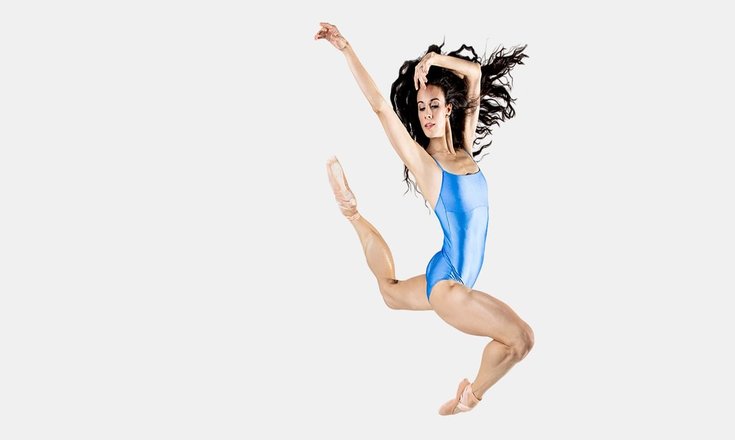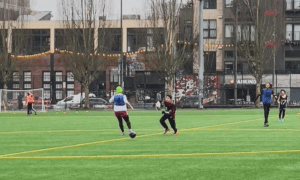4.5 STARS OUT OF 5 (Want to know exactly what our star ratings mean? Check out our explanations here.)
Every year, Pacific Northwest Ballet holds a Director’s Choice mixed-rep program, leaning away from established repertory with new works and risky choices. PNB Director, Peter Boal, overwhelmingly delivers quality performances on this precarious program year after year, and 2019 was no exception. This year, with two world premieres and one acquisition from San Francisco Ballet, Director’s Choice provides vitality and excitement to eager audiences in a night of three very different ballets: Bacchus, choreographed by Matthew Neenan of Pennsylvania Ballet and BalletX; The Trees The Trees by Robyn Mineko Williams, known for her work with Hubbard Street Dance Chicago; and In the Countenance of Kings by Justin Peck—arguably the biggest choreographer of our time. Let’s get into it!

Bacchus, the first ballet of the evening, is set to the wonderful music of Oliver Davis. The dancers are festive and merry, and then mysterious and full of depth. Davis’s music is clean and expressive, never reaching a great crescendo yet always building and soaring. Neenan used this expression to his advantage, giving each ‘character’ specific movements and phrases that they often repeated. There is no set, and the costumes are all varying shades of purple.
Neenan used repetition quite well; he would establish phrases, then show them again with the addition of more elements or an evolution into a related phrase. For instance, a quartet of men makes distinctive movements with their hands, wrists, and shoulders in unison in the second movement. The third movement sees a return of two such men (Kyle Davis and Price Suddarth) repeating the same phrase, then repeating again—only this third time, now that the audience has been trained to recognize it, the movement is used with two women (Angelica Generosa and Sarah-Gabrielle Ryan) reacting to it. The previously confusing movements suddenly make sense; were they partnering invisible women the whole time? Structurally, this repetition is fascinating. The motif tells the audience “Learn this! Pay attention!” and it works. I paid attention.

Costumes by Mark Zappone are sleek and streamlined, allowing the dancers to move without major distraction. The men’s costumes had an interesting design of a deep slit running up from the bottom to the collar on both the front and back. Also notable was the half-skirt they wore over their pants. The women’s costumes were more traditional, with a wonderful bodice of deep purple colors and an inter-crossing lattice of fabric stretching across their backs, mild skirts, and pointe shoes.
The costumes were, interestingly, different for each dancer. Notable examples include Leta Biasucci’s vibrant color, Seth Orza’s shirtless look, (perhaps matching Elizabeth Murphy’s skirtless one) and Christopher D’ariano’s wide cut shirt and dark kilt.
My main complaint with Bacchus is that it’s hard to find much meaning in it. The piece doesn’t have many dancers, and they are rarely all onstage at the same time. The choreographic motifs are perhaps overused, which tells me there was an intended message, but it never comes through. I am also unimpressed with the partnering–it retreads safe ground, landing on the wrong side of familiar and bordering cliche.
There were memorable moments, like soloist Margaret Mullin’s solo and a very satisfying section of musical silence where the dancers continued their movements. The work shows definite relationships and dynamics but loses itself in its lack of cohesion. I got tired of trying to decipher narrative or meaning, but there are obviously intentions behind each character. I just can’t discern what those intentions are, which is frustrating.
I loved Leta Biasucci’s performance, energetic and radiant. Margaret Mullin was thoughtful, almost to the point of mournful in her solo—my favorite part of the ballet. Seth Orza was powerful, but wasted; he had hardly any stage time. Kyle Davis and Price Suddarth inject humor and character into the ballet, moving briskly and gingerly like housepets that know they’re misbehaving and are determined to get away with it.
Don’t get me wrong, I quite liked Bacchus, and would watch it again. It was like fresh air, clean and satisfying, and ends on a gentle note rather than a big crescendo (which I appreciate). Unfortunately for Neenan, it felt overshadowed by the other two ballets shown, particularly In the Countenance of Kings. But we’ll get to that later.
The second work, Robyn Mineko Williams’s The Trees The Trees, was wildly different from Bacchus. The work was based upon the poetry of the same name by Heather Christle, and those poems were sung by the singular Alicia Walter. The sound design was fascinating and atmospheric, surrounding the audience. The score by Kyle Vegter was beautiful, and Walter was incredible, with wonderful vocal range both deep and high. She delivered the poetry in a way only possible for high-level singers; her voice was more akin to an instrument than anything else, but she could also recite in a speaking voice.

The costume design was tied in with the set—Director Peter Boal describes it as “Mad Men style living room,” and the mid-century vibe bleeds through into the dance and the audience. The set (by PNB’s Rico Chiarelli) was the angular white minimalist of modern abstract architecture, but actually felt deeply personal. The McCaw Hall stage is huge and often almost indifferent to the audience, maybe even standoffish. The set of The Trees gave the stage the appearance of a living room, far more familiar and intimate. The costumes by Branimira Ivanova reflected this, with (probably modified) street clothes and socks.
The movement style, self-described by choreographer Robyn Mineko Williams as “weird” and “challenging” is very contemporary. Dancers made geometric shapes with each other, contorting and stretching in ways impossible for ballet technique to allow. Even Alicia Walter was involved in the movement, wandering around the stage and occasionally interacting with the dancers.
I adored this piece. Christle’s poetry has a lot of relatability and accessibility contrasted with dramatic imagery, and the same can be said for the ballet. There were several partnerships throughout, including soloists Dylan Wald and Elle Macy, soloist Ezra Thompson and principal Noelani Pantastico (in her return to the stage after an injury) and corps member Christopher D’ariano and soloist Leah Merchant. D’ariano (who has been very well utilized this year since his breakthrough role in last year’s Director’s Choice) and his partnership with Leah Merchant is smooth and detailed. Elizabeth Murphy is phenomenal as well, but my favorite moment in the ballet was D’ariano’s solo near the end of the piece as the set moved and changed. His presence was almost suffocating, and the set gently floating away from him manufactured an interesting ‘tunnel vision’ effect in the audience.
The closing pas de deux between Wald and Macy (dating irl) took place on an even smaller stage than the rest of the ballet, but if anything felt bigger for it. They seemed closer to the audience, swaying as if under influence of gentle wind or waving water currents. Wald is a generous partner and Macy is all the more expressive for it. Their real-life chemistry must have been intentional on Williams’s part, and it paid off in a tender finale for the ballet.
Watch a rehearsal for The Trees The Trees here.
In the Countenance of Kings is, in my opinion, the highlight of the show. Choreographer Justin Peck is a bit of a ballet wunderkind, exploding into the choreography scene with 2012’s Year of the Rabbit and In Creases, both at New York City Ballet, where he is now resident choreographer and artistic adviser. He’s made more than 30 ballets, recently won a Tony award for Carousel, and is choreographing the Steven Spielberg West Side Story remake (filming this summer). Suffice to say he’s a big deal.
In the Countenance of Kings is actually not dissimilar to Year of the Rabbit, though they were made for different companies (Kings was made for San Francisco Ballet in 2016–watch their trailer for the ballet here). They are both energetic, geometric, set to music by indie-rocker Sufjan Stevens, and visually striking in their use of corps dancers and complex partnering. I would say Kings is better developed and more mature however; Peck has, after all, gotten a lot of practice between the two premieres.
The curtain opens to reveal what can only be described as a nest of dancers braided and wrapped together. Waves of them peel off from the nest to reveal “The Protagonist”: Principal Dancer Jerome Tisserand. Peck has said that Kings “has the bones of a narrative,” and is not fully abstract; or devoid of story. This reminds me of what I just disliked about Bacchus, but it is much more successful in this example. The main characters all have names: the women are known as Quantus (Elle Macy), Electress (Margaret Mullin) and Botanica (Laura Tisserand), while the men are known as The Protagonist, The Foil (Lucien Postlewaite) and The Hero (Joshua Grant). The corps is in the program as “The School of Thought”.

The Costumes are pretty similar between men and women, with white tops (and a splash of color), black tights, and white technique shoes for men and pink pointe shoes for women.
Tisserand is in his element, floating around, struggling to find purpose or direction until he is influenced by Quantus, Electress, Botanica, The Foil, and The Hero. Peck is particularly talented in his use of large groups of dancers. The School of Thought balances unison, symmetry and asymmetry, formations and individuality. Josh Grant and Laura Tisserand move effortlessly together, easily executing risky maneuvers and threading between shifting corps dancers with grace.
There is a distinctive lighting change, and Quantus and Electress (Macy and Mullin) stand facing each other, moving as if reflections of each other. This “mirror effect” is used throughout the movement. There is energetic, creative partnering involving almost the full cast See an excerpt here. Notice the repetition here; the same principle of repetition I found grating in Bacchus is much more interesting here. Peck uses addition, evolution, and speed with the repetition to a much higher degree than Neenan did, and the results are powerful and invigorating. Elle Macy stands out as powerful, expansive, and speedy. This is truly a star role and she shines like the sun.
LIGHT CHANGE– everything is now in silhouette until a spotlight catches The Foil and Electress performing difficult, but fun and exciting, partnering at great speed. The ballet proceeds from memorable moment to memorable moment, helped along by Brandon Stirling Baker’s thrilling light design.
Sufjan Steven’s score, from his avant-garde electric orchestration The BQE, is jazzy, then poppy, then noble and soaring. It refuses to be contained in one definition, or even five definitions. The result is a stunning mixture of sounds that, as it is put by PNB’s Doug Fullington, “runs the gambit of styles.” Peck uses this to his advantage, switching gears seamlessly from more classical movement to jazzy swaying to dazzling leaps. The complicated patterns in the music are directly reflected by the precise and explicit patterns set by the School of Thought.
At one point, Peck seems to challenge the audience with a line of all 18 dancers lying facedown on the stage, then slowly pushing up onto their arms and surveying the audience.
Another moment shows The Hero and The Foil competing in their pirouettes, trying to outdo the other with more turns. I could go on; the ballet is practically replaying itself in my head.
Without losing steam, the ballet ends rather suddenly with the full cast onstage running into the wings in the same seconds as the curtain drops.
This year’s Director’s Choice seems to be about youthfulness and life more than anything else. Celebration, appreciation of the everyday, thoughtful mystery, and young talent run throughout all three works and make a collective point; art is here to stay, and new work by young artists is always going to be valuable. A ballet company like PNB cannot survive off of only performing their signature repertory, they also need to grow, to push their own limits, to take risks. The dancers are capable and obviously love developing in different directions than purely classical ballet. Director’s Choice has always been about how the repertory would look if Boal had unlimited resources, but now it feels like a prediction of the future, and not just for ballet. Diversity is valuable in everything from racial contexts to shareholding to educational opportunities, and PNB is embracing diversity with its fantastic supply of new and different works.
Director’s Choice runs at McCaw Hall for four more shows: 7:30 PM Thursday, March 21st through Saturday, March 23rd with a 1:00 matinee on Sunday, March 24th.







Be First to Comment